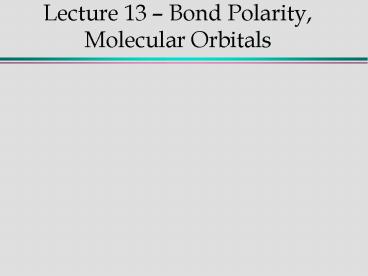Lecture 13 Bond Polarity, Molecular Orbitals - PowerPoint PPT Presentation
1 / 40
Title:
Lecture 13 Bond Polarity, Molecular Orbitals
Description:
Lecture 13 Bond Polarity, Molecular Orbitals. Dipole Moment, m. m ... Calculate the Bond Order: BO = no. of bonding. electrons. no. of antibonding. electrons ... – PowerPoint PPT presentation
Number of Views:47
Avg rating:3.0/5.0
Title: Lecture 13 Bond Polarity, Molecular Orbitals
1
Lecture 13 Bond Polarity, Molecular Orbitals
2
Dipole Moment, m
Q Q
r
- m Q r
- m has units of C m
- 1 D (Debye) 3.3 x 10-30 C m
3
Bond Polarity
m 1.93 D
d-
d
F
H
- Dipole moment
4
- Dipole
- Molecule Moment, D
- HF 1.93
- HCl 1.04
- HBr 0.80
- HI 0.38
5
Water - polar
- d
m 1.85 D
H
2 d-
O
H
d
6
Ammonia - polar
m 1.47 D
3 d-
d
N
H
H
d
H
d
7
NF3 - zero dipole
N
F
F
F
8
Carbon Dioxide
2 d
d-
d-
C
O
O
- No net dipole!
9
Methane - no dipole
d
H
4 d
C
d
H
H
d
H
d
10
- Valence Bond Theory
- localized overlap of atomic
- valence shell orbitals
- Hybrid Orbital Theory
- Localized overlap of hybrid
- and atomic orbitals
- MO theory
- orbitals delocalized over entire molecule
11
Molecular Orbital Theory
- atomic orbitals atoms
- MO molecules
12
MOs are...
- Linear Combinations of Atomic Orbitals (LCAO)
13
positive overlap a bonding orbital
electron density
-
nuclei
14
A bonding MO
s1s
1s
1s
15
Negative overlap is also possible...
a node
electron density
-
nuclei
16
An antibonding MO
-
s1s
1s
1s
17
Bonding results in stability
1s - 1s
Energy
1s
1s
1s 1s
18
add the MOs
s1s
s1s
H
H
H2
19
put electrons in the MOs
s1s
s1s
H
H
H2
20
put electrons in the MOs
s1s
s1s
H
H
H2
21
Will the molecule hang together or fall apart?
- Calculate the Bond Order
no. of bonding electrons
no. of antibonding electrons
-
BO
2
22
s1s
- for H2,
s1s
2 - 0
BO
1
2
BO gt 0, thus H2 is stable
23
other molecules, e.g. H2-
s1s
s1s
H
H
H2-
24
s1s
- for H2- ,
s1s
2 - 1
½
BO
2
BO gt 0, thus H2- is stable, (and has been formed
in the lab)
25
e.g. H2-2
s1s
BO0
s1s
H2-2
26
e.g. He2
s1s
BO0
s1s
He2
27
e.g. He2
s1s
BO½, found in stars!
s1s
He2
28
more complex molecules...
s2s
2s
2s
s2s
s1s
1s
1s
s1s
29
Li2
BO 1
s2s
2s
2s
s2s
s1s
1s
1s
s1s
30
Be2
BO 0
s2s
2s
2s
s2s
s1s
1s
1s
s1s
31
2p
2p
s2s
2s
2s
s2s
32
? bond
33
s2p
2p
2p
s2p
s2s
2s
2s
s2s
34
? bonds
? bond
35
s2p
p2p
2p
2p
s2p
p2p
s2s
2s
2s
s2s
36
N2, BO 3
s2p
p2p
s2p
p2p
s2s
s2s
37
O2, BO 2
s2p
p2p
s2p
p2p
s2s
s2s
38
F2, BO 1
s2p
p2p
s2p
p2p
s2s
s2s
39
Ne2, BO 0
s2p
p2p
s2p
p2p
s2s
s2s
40
MOs can explain observed physical properties
- e.g. bond energies,
- bond lengths,
- magnetic properties































